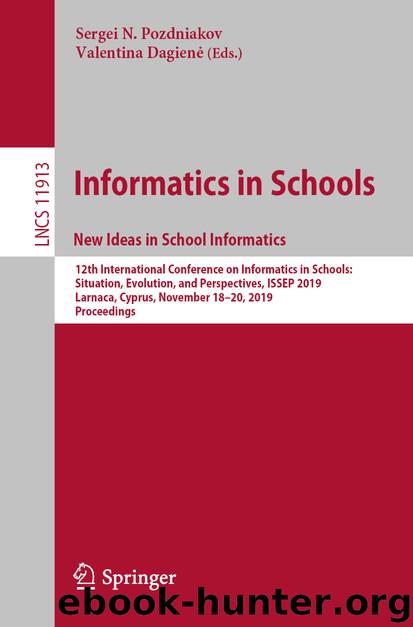Informatics in Schools. New Ideas in School Informatics by Sergei N. Pozdniakov & Valentina Dagienė

Author:Sergei N. Pozdniakov & Valentina Dagienė
Language: eng
Format: epub
ISBN: 9783030337599
Publisher: Springer International Publishing
Fig. 4.Part of a classification tree in Orange. (Color figure online)
Fig. 5.Confusion matrix for examining the analysis quality.
4 Evaluation in School
The lesson sequence was evaluated in two ninth grade classes of a German secondary school with 15 (three female) and 12 (no female) students respectively. Both classes were taught by the same teacher and had no pre-knowledge from teaching regarding data in general, databases or even programming. For organisational reasons, only three lessons (90 min each) were available, hence we had to drop the fourth lesson and included some of the discussion aspects in the other lessons, so that those were very packed. The first author of this paper observed the lessons using observation sheets and conducted a guided interview with the teacher. Also, the students were interviewed with questionnaires at the end of the last lesson in order to cover different perspectives.
In general, the observations were rather positive: Although both courses were very different concerning students’ interest in the topic and their motivation to participate in discussions, in general most students were taking part after a while, which was also surprising for the teacher, who did confirm this observation. Generally spoken, there was a large overlap between the researcher’s and teacher’s observations. In contrast, the students’ perspective on the topic seemed a bit different in the questionnaires, but there was a high variation in their answers in almost all questions asked. As the questionnaire was handed to them as the last task of the lesson and hence also filled in by them very quickly, these results have to be considered carefully. Yet, taking together the three methods, there are some central results that can be deduced:
Interest and Motivation: Although the evaluation took place in two rather difficult, both inattentive and poorly motivated classes, both the classroom observation and the perception of the teacher showed a high interest and a motivated participation. According to the teacher, both the interest in the topic and the motivation seemed to be higher than for other topics. In addition, the frequent and intensive discussions were highly noticeable, which was unusual in particular for one of the classes. However, the student survey partly contradicted these observations, especially with regard to the perceived interest in the topic, which was rated as rather low.
Prior Knowledge and Experience: In the course of the lessons it became apparent several times that the examples used and the entire topic have strong references to the daily life of the students and to their experiences: In many cases, they additionally brought their own examples and were able to find intuitive explanations for questions that arose. Based on the students’ ideas, even the data analysis process could be deduced well. Thus, it became clearly recognizable that data and data analysis play an important role in students’ life and that they have some ideas on how these work.
Comprehensibility: In general, the topics considered in the lesson sequence seemed to be comprehensible and understandable for the students. This was particularly evident in the discussion phases, where they often included aspects in their argumentations that had been considered earlier.
Download
This site does not store any files on its server. We only index and link to content provided by other sites. Please contact the content providers to delete copyright contents if any and email us, we'll remove relevant links or contents immediately.
Algorithms of the Intelligent Web by Haralambos Marmanis;Dmitry Babenko(8522)
Test-Driven Development with Java by Alan Mellor(7389)
Data Augmentation with Python by Duc Haba(7290)
Principles of Data Fabric by Sonia Mezzetta(7037)
Learn Blender Simulations the Right Way by Stephen Pearson(6972)
Microservices with Spring Boot 3 and Spring Cloud by Magnus Larsson(6797)
RPA Solution Architect's Handbook by Sachin Sahgal(6206)
Hadoop in Practice by Alex Holmes(6030)
The Infinite Retina by Robert Scoble Irena Cronin(5905)
Jquery UI in Action : Master the concepts Of Jquery UI: A Step By Step Approach by ANMOL GOYAL(5873)
Big Data Analysis with Python by Ivan Marin(5715)
Life 3.0: Being Human in the Age of Artificial Intelligence by Tegmark Max(5402)
Pretrain Vision and Large Language Models in Python by Emily Webber(4676)
Infrastructure as Code for Beginners by Russ McKendrick(4458)
WordPress Plugin Development Cookbook by Yannick Lefebvre(4189)
Functional Programming in JavaScript by Mantyla Dan(4124)
The Age of Surveillance Capitalism by Shoshana Zuboff(4115)
Embracing Microservices Design by Ovais Mehboob Ahmed Khan Nabil Siddiqui and Timothy Oleson(3975)
Applied Machine Learning for Healthcare and Life Sciences Using AWS by Ujjwal Ratan(3953)
